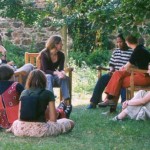The place of teaching when the church gathers

When you talk with someone about church today, it’s hard to keep the conversation from shifting to the church gathering (i.e., “worship service”). This is true even among people who admit that the church is people (that is, people who are following Jesus). Still, people often equate (or at least closely associate) church with a specific gathering of people.
Similarly, when discussing gathering with the church, it’s hard to keep the conversation from shifting to some form of teaching (usually in a lecture form called “sermon” or “homily”). In fact, just as church is often associated with a specific gathering, the gathering itself is often closely associated with a sermon or another form of teaching.
However, in my post “What is teaching from the perspective of Scripture,” I said that teaching in Scripture is not about sharing information but about demonstrating how to live for Christ and helping others live that way of life. Obviously, very little can be demonstrated while teaching during church gatherings. (Like I said in the post above, “application” is not the same as demonstration.)
So, what is the place of teaching when the church gathers?
First, we should recognize that in Scripture teaching is only one form of interaction between people when the church gathers. And, beyond it being only one form of interaction, it is not given a prominent place. One of the only places in Scripture where teaching (“instruction”) is specifically mentioned in the context of church gatherings is in 1 Corinthians 14. However, even in this case, teaching is only one among a list of activities, and it is not one of the activities that Paul chose to focus on. (There may be a reason that Paul chose to focus on “prophecy” and “tongues,” but he doesn’t tell us that reason in his letter.)
Second, whether we teaching using lecture, dialog, discussion, case studies, or some other method, we should recognize that these kinds of teaching are only the beginning of teaching in the perspective of Scipture – and only a small step at that. If someone only interacts with others through these kinds of teaching methods, then that person is not teaching by demonstration (like we see in Scripture). (Yes, I believe that some forms of teaching are better for sharing information than others forms. But, any of those forms are still types of sharing information, not methods to help people walk in Christ as a way of life.)
Finally, we should recognize that if we truly desire to teach one another, then we must also grow to know one another more and more and share our lives with one another. Real life is the context for teaching in the perspective of Scripture. Anything that is shared while the church gathers only becomes “teaching” when it demonstrated in the context of real life and others are helped to live accordingly.
I understand that it is popular to closely associate caring about Scripture or learning from Scripture with certain forms of teaching (sermons, for example) or certain contexts for teaching (during the church gathering or worship service, for example). However, this is not a valid (or at least a unique) association. It is much more “scriptural” to associate caring about Scripture with helping others live according to what we find in Scripture.
What would you add to my discussion of teaching while the church gathers? Have you experienced this kind of teaching before?

So wait a second, the manner of our lives is also a form of teaching? How does that work, the only way we can see that is if we spend time together?!
Arthur,
No… that’s not what I said. I didn’t say the manner of our lives was A form of teaching… 🙂
-Alan
Alan,
These are great thoughts. I’ve been trying to wade through and understand the role of teaching in the church, especially as I’ve been on a journey pursuing simple church in my city. I think one of the difficulties we have in breaking out of a lecture-centric mode of teaching is that this mode is what we’ve experienced from age 5 through 18 in grade school, and then perhaps for another 2-10 years in college/grad school and beyond! Your observations probably speak as well to some of the inadequacies in our current education system to really help people learn.
I still preach on occasion (but not often) in a more one-to-many situation, but I’ve been finding that the more I can bridge what I think the text says to actual life situations that I’m encountering, the more meaningful, relevant, and applicable it is.
Ultimately, I think the sort of teaching you are describing will be more natural, more sustainable, and more transferable in the long-term. Thanks for writing!
If you have any encouragement from being united with Christ, if any comfort from his love, if any fellowship with the Spirit, if any tenderness and compassion, then make my joy complete by being like‑minded, having the same love, being one in spirit and purpose. Do nothing out of selfish ambition or vain conceit, but in humility consider others better than yourselves.
Philippians 2: 1~3
****
Using this as a possible frame for gatherings we would esteem others, seek to learn from others,(which is learning from Christ)and in doing so submit to the Headship of Christ.
informative post Alan, thanks!